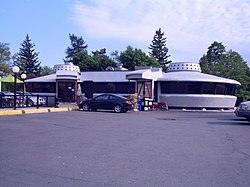List of Googie architecture structures (Canada)
Appearance
List of Googie architecture structures (Canada) | |
|---|---|
 Flying Saucer Restaurant |
This is a list of Googie architecture structures in Canada which includes a photographic gallery with a brief description of some of the structures which still remain. Googie was an original architectural style which began in Southern California during the late 1940s. Influenced by the coming of the Space Age, the Googie-themed architecture popularity was most notable during the mid-1960s, among motels, coffee houses and gas stations. The term "Googie" comes from a now defunct coffee shop and cafe built in West Hollywood[1] designed by John Lautner.[2][3]
List
[edit]The following are images of some of the Googie architecture structures remaining in Canada.
Googie architecture structures in Canada
| Name of structure[4] | Image | Location / Notes |
|---|---|---|
| Skylon Tower[5] | 
|
Niagara Falls, Ontario, Canada / c. 1965 |
| Peter Pan Restaurant [6] | 711 University Ave, Charlottetown, Prince Edward Island; restaurant closed and abandoned [citation needed] | |
| Terrebonne Cinemas [7] | 1071 Chemin du Côteau, Terrebonne, Quebec | |
| Canadian Tire Gas Station (30 built with only a few remaining in Ontario)[8] | 
|
2025 Kipling Avenue, Etobicoke, Ontario (1968) 1212 Southdown Road, Mississauga, Ontario (c. 1969) 314 Main Street East, Hamilton, Ontario (c. 1960s) 135 West Street South, Orillia, Ontario (demolished) |
| Flying Saucer Restaurant [9] | 
|
6768 Lundy's Lane, Niagara Falls, Ontario (c. 1974) |
| Cineplex Odeon Vaughan [10] | 3555 Highway 7 West, Woodbridge, Ontario; retro space saucer roof | |
| Metro supermarket at Parkway Mall, Toronto [11] | 
|
85 Ellesmere Road, Scarborough (1958) |
| Retro McDonald's stores in Toronto [12] | 
|
520 Oxford St W, London, ON N6H 1T5. 6410 Millcreek Dr, Mississauga, Ontario L5N 0B8. |
See also
[edit]References
[edit]- ^ Nelson, Valerie J. (2011-04-26). "Eldon Davis dies at 94; architect designed 'Googie' coffee shops". Los Angeles Times. Retrieved 2011-05-15.
- ^ John Lautner Why Do Bad Guys Always Get The Best Houses? October 31 by Rory Stott ArchDaily
- ^ Friedlander, Whitney (May 18, 2008). "Go on a SoCal hunt for Googie architecture". Baltimore Sun. Los Angeles Times. Retrieved 2009-02-11.
It was the 1950s. America was a superpower, and the Los Angeles area was a center of it. The space race was on. A car culture was emerging. So were millions of postwar babies. Businesses needed ways to get families out of their automobiles and into coffee shops, bowling alleys, gas stations and motels. They needed bright signs and designs showing that the future was now. They needed color and new ideas. They needed Googie.
- ^ "National Register Information System". National Register of Historic Places. National Park Service. April 24, 2008.
- ^ Official website
- ^ "Review: Here's hoping Peter Pan Bistro grows up". The Globe and Mail. 2015-06-05. Archived from the original on 2022-08-18.
- ^ Cinema Treasures
- ^ "Canadian Gas Stations | RoadsideArchitecture.com". roadarch.com. Retrieved 2017-12-16.
- ^ Roadside America
- ^ Cineplex Entertainment (2012-01-18). "Cineplex Celebrates 100 Years of Movie Memories". Retrieved 2013-06-27.
- ^ Star: Parkway Mall Metro store nominated as heritage property
- ^ A peek inside McDonald’s top secret convention
Further reading
[edit]- Googie: Fifties Coffee Shop Architecture; by: Alan Hess; Publisher: Chronicle Books; ISBN 978-0877013341.
- Googie Redux: Ultramodern Roadside Architecture; by: Alan Hess; Publisher: Chronicle Books; ISBN 978-0811842723.
Wikimedia Commons has media related to
Googie architecture.
Googie architecture.
